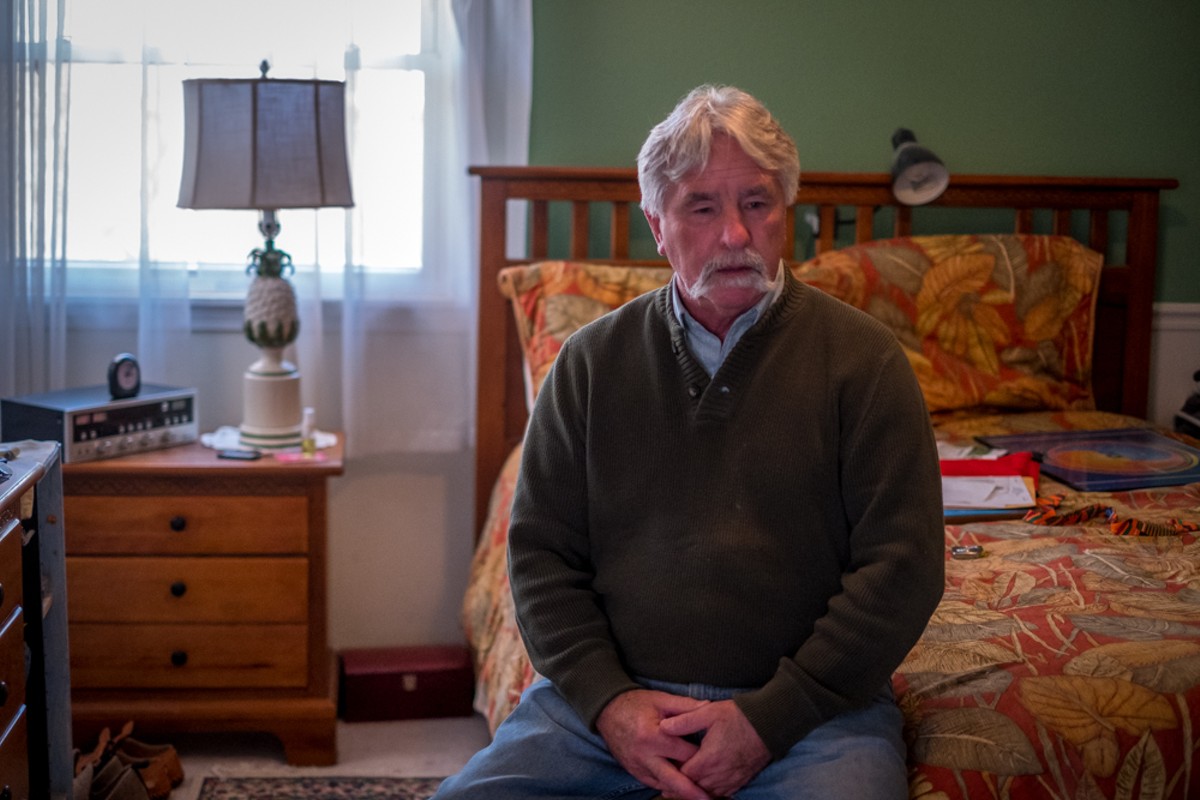A few months ago, Kevin FitzGerald was driving along Interstate 44 toward St. Louis when his iPhone buzzed.
FitzGerald picked it up.
The voice on the other end: a man in his early twenties in Ontario, Canada, who had just injected cocaine.
"I already used, and I need to talk to somebody," the caller said, as FitzGerald recalls.
So they talked.
The two strangers gabbed on and on as FitzGerald turned off the highway and looped through side streets.
"We talked politics a lot," FitzGerald says. "We're comparing education and health care. He told me he was bipolar. We talked literally for two hours. He was a wonderful young man."
FitzGerald, 68, is a volunteer operator for an international program called Never Use Alone, a rapidly growing overdose response line for people using drugs alone.
The group, which has no headquarters and exists virtually, runs a toll-free, 24/7 hotline (800-484-3731) that connects substance users from all over the United States and Canada with volunteer operators.
Volunteers such as FitzGerald stay on the line and talk to users, who provide contact and location information. Volunteers are trained to check in every two or three minutes to confirm the users are still responsive.
If the person on the other end of the line stops responding, then the volunteer immediately calls for help. If the call ends uneventfully, as it does in the vast majority of cases, then the operator destroys all contact and location information.
FitzGerald, a well-known St. Louis labor activist, contacted the Riverfront Times about Never Use Alone because he thinks it works.
"My main thing is to get the word out about this program," he says. "Because it can literally save lives."
Never Use Alone, or NUA, began only a few years ago, the brainchild of a recovering heroin user in Tennessee who was inspired by a Facebook posting. So far, the service is already showing clear promise as one of the few effective ways to turn the tide on America's raging epidemic of drug overdose deaths.
In preliminary figures released in early November, the federal Centers for Disease Control and Prevention reported that more than 100,000 Americans died of drug overdoses for the twelve-month period between May 2020 and April 2021 — a dubious all-time record that eclipsed the previous annual mark of 93,000 OD deaths.
The overdose epidemic shows no signs of abating. More than 75 percent of America's OD deaths were caused by opioids, a class of powerful painkillers that includes morphine and heroin and name-brand painkillers such as OxyContin. And more than 64,000 of the deaths were due to synthetic opioids such as fentanyl.
Fentanyl, a painkiller up to 100 times more powerful than heroin, is now pervasive both nationwide and in the St. Louis region. Because of its highly addictive — and therefore profitable — nature, fentanyl is routinely added to heroin, but is also mixed in with a wide range of other black-market drugs, including cocaine and methamphetamine as well as counterfeit versions of OxyContin and the antidepressant Xanax.
Fentanyl, unlike heroin, is a synthetic drug. It can be made anywhere.
The center of global fentanyl production is still Wuhan, China, because of the cheap and widespread availability of the precursor chemicals needed to make it. But it is increasingly manufactured in secret U.S. labs, which has made law-enforcement crackdowns much more difficult.
Many people who OD on fentanyl don't even realize they're ingesting it at the time. And if they're using the drug alone — which is common because of the stigma attached to illegal drug use and the isolation caused by the COVID-19 pandemic — then the odds of a fatal overdose skyrocket, according to FitzGerald.
Substance users whom he talks to on the NUA hotline have become especially wary, he says.
"What are you using?" FitzGerald recently asked a caller. "He goes, 'I would say heroin, but it's fentanyl.'"
A woman that FitzGerald spoke to on the NUA line in mid-November told him she had in her possession a can of Narcan, the brand name of Naloxone, a drug that can reverse an opioid overdose. She had the Narcan in case she OD'ed on the methamphetamine she was taking.
"You don't know what's in this shit anyway," FitzGerald recalls her telling him.
Never Use Alone is part of a category of tactics to fight drug abuse known as harm reduction.
As such, it belongs on a list of options that not-for-profits and government agencies are increasingly turning to as part of a multipronged strategy to stem America's record-setting epidemic of drug overdose deaths. Roots of the epidemic stretch back nearly 30 years. That's when OxyContin's maker, Purdue Pharma, launched a campaign of cutthroat profit-making by showering tens of millions of its pills upon an unsuspecting rural America, triggering the current cycle of addiction and death.
Only in recent years have courts and regulators cracked down, leading to multi-billion-dollar settlements negotiated with Purdue Pharma and other major drugmakers and distributors, such as Johnson & Johnson and McKesson. The deals will almost certainly ensure the companies will avoid ever admitting any wrongdoing — or face criminal charges — in America's deadly epidemic. But there's a clear line between the profit-making of pushing an obscene number of prescription pills on the country and the death and destruction wrought by addiction.
Looking back, the fentanyl scourge that followed seems inevitable.
The growing push for harm reduction is born out of necessity. Tactics have included distributing free Narcan and fentanyl test strips to the public, needle exchange programs and safe injection sites.
Nothing else — from stepped-up enforcement at America's southern border to Congress allocating more resources for the prosecution of drug gangs — seems to be making a dent in America's OD death crisis, which continues to grow like a metastasizing cancer.
It was only twenty years ago that about 20,000 Americans a year were dying from illegal drug use. By 2011, that number had doubled to 40,000.
By 2019, it had doubled again, to 80,000. It took only another two years for the number of OD fatalities to surpass 100,000 — a nearly 30 percent increase from the previous year, but still a much smaller figure than the true number of OD fatalities, according to some substance-abuse experts.
America's OD death rate is truly shocking when compared to the rest of the world's wealthy nations.
Poland and Turkey recorded some of the lowest rates, at 0.4 deaths per 100,000, while Norway came in at the second-highest rate, at five deaths per 100,000.
And America? It blew away the competition. It recorded an OD death rate of 21.1 deaths per 100,000, or more than four times Norway's.
Jenny Armbruster, the deputy executive director of PreventEd, one of the St. Louis region's leading drug education groups, called Never Use Alone "a good strategy. We always encourage people not to use alone."
Armbruster described NUA as an important option to prevent fatal overdoses for people who "don't have someone perhaps in their life that they're able to use around or [are] isolated for a variety of reasons."
The Drug Enforcement Administration has made cracking down on fentanyl makers and traffickers a top priority, according to Armbruster.
But like so many things in the drug economy, "it's like pushing down on one part of a balloon," she says. "It will move to another area."
Meanwhile, law enforcement and drug education professionals are girding for the next big thing in lethal drugs.
Is it something called "benzo dope"?
Canadian physicians are already warning that benzo dope, a highly dangerous synthetic street drug, is on the rise in Canada. A mixture of fentanyl and black-market benzodiazepines, a class of tranquilizers, benzo dope leaves drug users even more prone to fatal overdoses than fentanyl alone.
Benzo dope's deadliness stems from the fact that Narcan is not effective against it. Last year, forensic drug experts in the Canadian province of British Columbia found that one in six fentanyl deals were cut with benzodiazepines — a class of tranquilizer that had not typically been found mixed into opioids — compared to 5 percent last January and zero before 2019.






